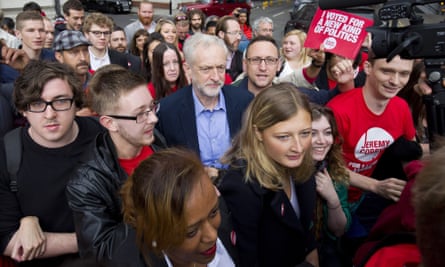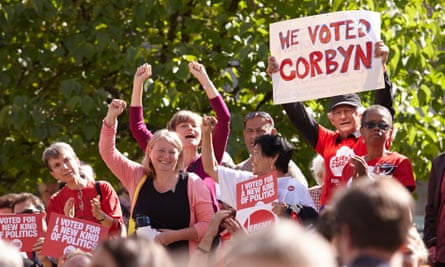Jeremy Corbyn’s hopes of remoulding Labour have been boosted by a detailed Guardian survey into the party at grassroots level that shows overwhelming support for him, a decisive shift to the left and unhappiness with squabbling among MPs.
The Guardian has interviewed Labour secretaries, chairs, other office holders and members from more than 100 of the 632 constituencies in England, Scotland and Wales. Almost every constituency party across the country we contacted reported doubling, trebling, quadrupling or even quintupling membership, and a revival of branches that had been moribund for years and close to folding.
Reflecting increased interest among the young, university cities and towns recorded some of the biggest rises, with Bath jumping from 300 to 1,322 members (911 full members, 120 affiliated supporters and 291 registered supporters) and Colchester from 200-250 to almost 1,000. Neither are traditional Labour seats.
The survey findings are borne out by Labour’s national figures, released to the Guardian in a break with party tradition of keeping them secret. Membership jumped from 201,293 on 6 May last year, the day before the general election, to 388,407 on 10 January.
Party membership figures are a controversial issue, with the former cabinet minister Peter Mandelson, who is opposed to Corbyn, telling a Labour meeting in the Lords last month that “30,000 long-term members have left the party, real members, tens of thousands”.
But the newly released figures undermine his claim, showing a total of 13,860 have left since the general election, some of them having resigned while others have gone as part of natural churn. The increase in membership is continuing, with just under 1,000 having joined since Christmas Eve.

The Guardian survey, coming after months of infighting within the Parliamentary Labour party (PLP) following Corbyn’s leadership victory, provides an opportunity for the voices of the party grassroots to be heard.
The survey found:
- The rise in membership has been uneven across the country. In contrast with steep rises in London and elsewhere in England and Wales, the rises in Scotland have been relatively modest, ominous for the party’s hopes in May’s Scottish parliamentary election.
- Members, in spite of unhappiness with public splits within the PLP, say there is no appetite for deselection of MPs. But some acknowledge that proposed boundary changes in 2018 could result in de-facto deselection.
- Returning members, who had left Labour mainly in protest over the 2003 Iraq invasion, are making an immediate impact, partly because they are familiar with the rules.
- Both returning members and new ones tend to be mainly leftwing. There are few reports of attempted infiltration from hard-left groups.
Labour membership figures have long been volatile. Membership rose to 407,000 when Tony Blair became prime minister in 1997 but soon after went into decline, as disillusionment set in among leftwingers, turning into mass desertions over Iraq. By 2010, membership stood at 185,000.
The breakdown of Labour’s latest figures shows two surges last year, one partly in response to the election result and Corbyn’s entry into the leadership campaign and another after he became leader.
Between 7 May and 11 September, 116,753 joined and 5,393 left – 4,066 of whom cancelled their direct debit without informing the party why – and 1,327 resigning. Between Corbyn becoming leader on 12 September and Christmas Eve, 87,158 joined, with 8,567 leaving, of whom 4,692 cancelled their direct debit and 3,875 resigned. (The number of joiners and leavers do not match the total membership figure because the party allows a six-month grace period before cancelling membership.)

The Guardian survey reflected this. Constituency office holders reported three surges last year: the first after the Conservative victory in May, the second after Corbyn entered the leadership race and again when he became leader.
The constituencies attributed this mainly to the Corbyn effect. Garry Parvin, High Peak constituency secretary, reported an increase in membership from 100 to 463 – with 259 joining after the May election before and 30 September. “In the main, yes, they are Corbyn supporters,” he said.
Asked whether remaking the party to reflect leftwing values was more important to them than winning the 2020 general election, Parvin said: “Frankly, yes. There are a lot of ideologically driven people who feel that we’re going to lose anyway so we may as well lose on principle.”
Breaking this down, Joanne Hepworth, constituency secretary for Pontefract and Castleford, West Yorkshire, said: “We’ve had 360 new members since the election. We have 610 now. Between 7 May and 12 August, we had 144 new members. The rest have joined since then, mostly during the leadership race.”
That view is not universal. Brynmor Hollywell, constituency party secretary for Caerphilly, south Wales, said: “A lot of us are disturbed about Corbyn. He’s a wonderful individual but not a potential prime minister.”
Overall, though, support for Corbyn at grassroots level suggests he will eventually prevail in his battle with the PLP or if there was to be an attempted coup.
Some constituencies do complain that none of the young members have turned up yet for meetings or turned up only once, but others say young members are already actively engaged, with some constituencies reporting potential rifts between long-term members used to rule-bound discussions and the younger ones seeking more zest and passion in their politics.

Christina Watkins, constituency secretary for Southampton and Romsey, said: “We’ve had a lot of older members coming back who think meetings and local politics should be conducted in the same way as it was in the 70s and 80s. Rather than go to the pub or have a glass of wine at someone’s house, the returning members want to meet in a town hall and sit around calling each other ‘comrade’ and ‘Mr Chairman’,” she said.
“At some point there is going to be a collision between these older and younger people: those that see this as a return to the old politics and those who see it as a new kind of politics.”
The creation late last year of the group Momentum, which is open to non-Labour members as well as members, is, according to the organisers, not to deselect anti-Corbyn or Blairite MPs but to harness this enthusiasm of the young.
Diana Page, Bath constituency vice-chair, said: “They are mainly Corbyn supporters, some of them enthusiastic Corbyn supporters, who joined specifically because of him. They’ve been very prepared to work and have brought in their expertise. They’ve been quite active in doing the work, not just the talking. A number of them had left during the Blair years and the Iraq war. What they are not is members of the far left. These people are in no way like the radicals of the 70s and 80s.”
The survey shows little interest at constituency level in deselection. But members acknowledge that if the government plan goes ahead to have boundary changes in 2018, reducing the number of seats to 600, there could be de-facto deselection.
Asked about deselection, Damian Corfield, Dudley North constituency secretary, said: “People have talked about it, but it is not a serious issue in the CLP.”
Constituency parties are reporting members wanting a say on the major issues such as the Commons vote last month on bombing Syria.

Steve Wilson, election agent for Angela Smith, MP for Penistone and Stocksbridge, in South Yorkshire – who voted in favour of air strikes – said: “There were about 14 very negative emails/phone calls from members not happy with how Angela voted.”
David Plowman, constituency secretary for South Suffolk, said the Syria issue illustrated the impact of the new members. “We had an online discussion and about 90% were against airstrikes and 10% for. Before the new members it would have been about 60% to 40%. It would not have been as definitive. People were heavily and passionately against them,” Plowman said.
Research and reporting by Jonathan Bucks, Charlie Brinkhurst-Cuff and Oliver Milne

Comments (…)
Sign in or create your Guardian account to join the discussion